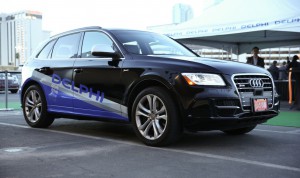
Delphi is demonstrated the capability of its automated driving system by driving an Audi Q5 from San Francisco to New York City.
Autonomous driving and autonomous vehicles face some serious challenges in the litigious and risk-adverse American society of the 21st century, according to discussions at the annual Society of Automotive Engineers Conference in Detroit.
The expectations and challenges of automated driving technology are critical to the future of the automobile business, Toshio Yokoyama, a executive from Honda Research & Development, who is one of the Japanese automaker’s leading experts on electronics during a panel discussion on automated driving.
Steffen Linkenbach, head of Systems and Technology, North America for Continental AG, said the idea that autonomous driving could reduce traffic fatalities and injuries is helping propel the autonomous driving concept and animated projects such as Volvo’s City Safety car, which is aimed at preventing accidents on congested urban areas.
Seval Oz, chief executive officer of Continental AG’s new Intelligent Transportation Systems unit, which is based in California’s Silicon Valley, said companies such as Google, Apple and Tesla have revolutionized the auto industry’s mindset. Without Silicon Valley’s initiative, automated driving would have remained hidden away in the research labs of the word’s carmakers “for 20 years,” Oz told reporters.
Google and the other Silicon Valley companies have helped force changes in the mindset of automakers and set the stage for a regulatory revolution by forcing legislators in California, Nevada and other states and the National Highway Transportation Safety Administration to begin revising laws and regulations.
“The regulators were even further behind than the automakers,” she said. In turn, the changes in regulations forced by Google in states, such as California, have allowed driverless cars to reach public roads, said Oz, who had worked in the development area devoted to the Google car before she joined Continental last year.
Bryant Walker Scott, a law professor at the University of South Carolina who participated in the SAE’s autonomous vehicle panel, noted that autonomous driving and autonomous vehicles are producing a challenge for courts and regulators. “In New York, there is a law that says you have to have one hand on the steering wheel at all times,” he said.
(Google’s Kurzweil says autonomous cars are coming. For more, Click Here.)
Some state laws that now allow driverless cars on the road are being re-written, Scott said. “What happens when a driverless car crosses state lines and that is going to happen,” he added, adding the patchwork of laws adopted by various states such as California, Nevada and Michigan are hardly a panacea. Ultimately, a federal law covering all 50 states might be needed to resolve the state versus state issues he suggested.
In the private sector, the liability issues are a key issue. Americans are terrible drivers they speed, fail to obey the traffic regulations and smash up their cars. The legal system, along with the insurance companies, has adapted to that kind of reality.
The autonomous car will require a complete change in the driving ecosystem, he said. “Do you let other cars speed around driverless cars,” he said, or do you enable technology that makes it difficult for other drivers to speed around driverless vehicles.
(Click Here for details about the autonomous Chevrolet-FNR.)
Companies, such as carmakers, that are now somewhat removed from the operation of the transportation system are going to have to get a lot closer as more and more data about vehicle operations becomes available.
“Companies get a lot closer to the system as data bring them closer and increases liability,” he said.
In the future, companies when cars are equipped with autonomous systems and artificial intelligence aimed at making vehicles accident proof more liability of all sorts is bound to accrue to the manufacturers.
Currently, the liability is actually more diffuse as costs are spread to insurance companies and individual drivers.
In theory, the cost of accidents to society should drop as deaths and injuries are reduced, making liability for everyone less expensive.
(To see more about how autonomous vehicles might make you carsick, Click Here.)
However, at the same time, the cost of insurance will have to change. New models are already emerging, such as usage models that allows drivers to pay for coverage only when they driver the vehicle, Scott said.
“Insurance must become more flexible,” Walker said. But the uncertainty that insurance companies face makes pricing of new policies more difficult.

Regulations and addressing the ethical issues are years behind the mechanical development of AVs. It’s time that these seriously important issues be resolved before AVs are allowed out on the highways unattended. The number of issues and complexity is downright staggering, IMO.